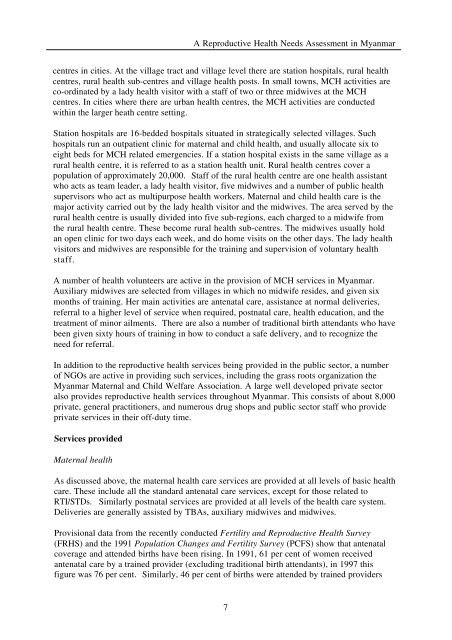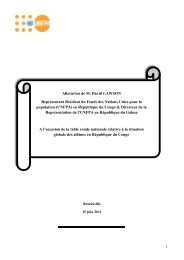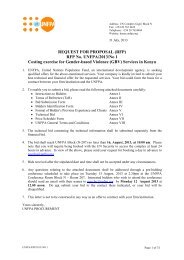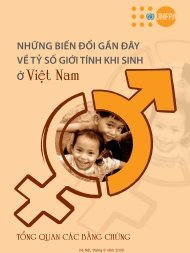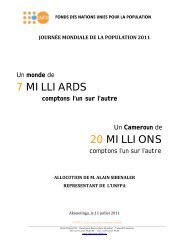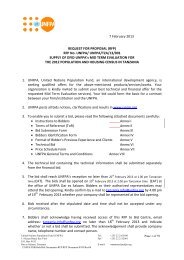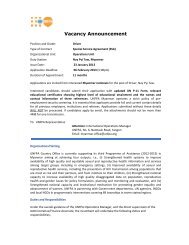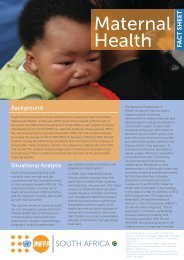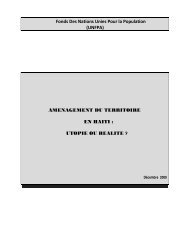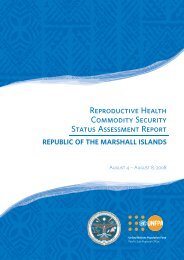A reproductive health needs assessment in Myanmar
A reproductive health needs assessment in Myanmar
A reproductive health needs assessment in Myanmar
You also want an ePaper? Increase the reach of your titles
YUMPU automatically turns print PDFs into web optimized ePapers that Google loves.
A Reproductive Health Needs Assessment <strong>in</strong> <strong>Myanmar</strong><br />
centres <strong>in</strong> cities. At the village tract and village level there are station hospitals, rural <strong>health</strong><br />
centres, rural <strong>health</strong> sub-centres and village <strong>health</strong> posts. In small towns, MCH activities are<br />
co-ord<strong>in</strong>ated by a lady <strong>health</strong> visitor with a staff of two or three midwives at the MCH<br />
centres. In cities where there are urban <strong>health</strong> centres, the MCH activities are conducted<br />
with<strong>in</strong> the larger heath centre sett<strong>in</strong>g.<br />
Station hospitals are 16-bedded hospitals situated <strong>in</strong> strategically selected villages. Such<br />
hospitals run an outpatient cl<strong>in</strong>ic for maternal and child <strong>health</strong>, and usually allocate six to<br />
eight beds for MCH related emergencies. If a station hospital exists <strong>in</strong> the same village as a<br />
rural <strong>health</strong> centre, it is referred to as a station <strong>health</strong> unit. Rural <strong>health</strong> centres cover a<br />
population of approximately 20,000. Staff of the rural <strong>health</strong> centre are one <strong>health</strong> assistant<br />
who acts as team leader, a lady <strong>health</strong> visitor, five midwives and a number of public <strong>health</strong><br />
supervisors who act as multipurpose <strong>health</strong> workers. Maternal and child <strong>health</strong> care is the<br />
major activity carried out by the lady <strong>health</strong> visitor and the midwives. The area served by the<br />
rural <strong>health</strong> centre is usually divided <strong>in</strong>to five sub-regions, each charged to a midwife from<br />
the rural <strong>health</strong> centre. These become rural <strong>health</strong> sub-centres. The midwives usually hold<br />
an open cl<strong>in</strong>ic for two days each week, and do home visits on the other days. The lady <strong>health</strong><br />
visitors and midwives are responsible for the tra<strong>in</strong><strong>in</strong>g and supervision of voluntary <strong>health</strong><br />
staff.<br />
A number of <strong>health</strong> volunteers are active <strong>in</strong> the provision of MCH services <strong>in</strong> <strong>Myanmar</strong>.<br />
Auxiliary midwives are selected from villages <strong>in</strong> which no midwife resides, and given six<br />
months of tra<strong>in</strong><strong>in</strong>g. Her ma<strong>in</strong> activities are antenatal care, assistance at normal deliveries,<br />
referral to a higher level of service when required, postnatal care, <strong>health</strong> education, and the<br />
treatment of m<strong>in</strong>or ailments. There are also a number of traditional birth attendants who have<br />
been given sixty hours of tra<strong>in</strong><strong>in</strong>g <strong>in</strong> how to conduct a safe delivery, and to recognize the<br />
need for referral.<br />
In addition to the <strong>reproductive</strong> <strong>health</strong> services be<strong>in</strong>g provided <strong>in</strong> the public sector, a number<br />
of NGOs are active <strong>in</strong> provid<strong>in</strong>g such services, <strong>in</strong>clud<strong>in</strong>g the grass roots organization the<br />
<strong>Myanmar</strong> Maternal and Child Welfare Association. A large well developed private sector<br />
also provides <strong>reproductive</strong> <strong>health</strong> services throughout <strong>Myanmar</strong>. This consists of about 8,000<br />
private, general practitioners, and numerous drug shops and public sector staff who provide<br />
private services <strong>in</strong> their off-duty time.<br />
Services provided<br />
Maternal <strong>health</strong><br />
As discussed above, the maternal <strong>health</strong> care services are provided at all levels of basic <strong>health</strong><br />
care. These <strong>in</strong>clude all the standard antenatal care services, except for those related to<br />
RTI/STDs. Similarly postnatal services are provided at all levels of the <strong>health</strong> care system.<br />
Deliveries are generally assisted by TBAs, auxiliary midwives and midwives.<br />
Provisional data from the recently conducted Fertility and Reproductive Health Survey<br />
(FRHS) and the 1991 Population Changes and Fertility Survey (PCFS) show that antenatal<br />
coverage and attended births have been ris<strong>in</strong>g. In 1991, 61 per cent of women received<br />
antenatal care by a tra<strong>in</strong>ed provider (exclud<strong>in</strong>g traditional birth attendants), <strong>in</strong> 1997 this<br />
figure was 76 per cent. Similarly, 46 per cent of births were attended by tra<strong>in</strong>ed providers<br />
7


